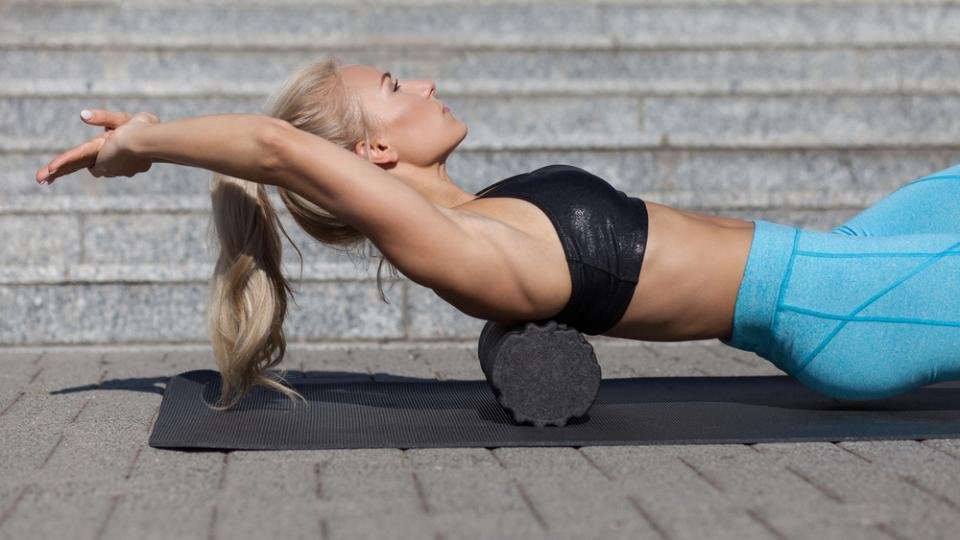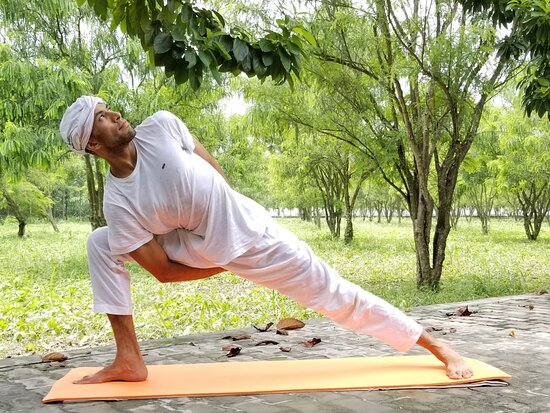
Yoga's restorative poses have many benefits. These include improved circulation, stronger bones and muscles, as well as improved nerve function. It can help reduce stress and improve your sense of well-being. These poses are especially beneficial for people suffering from sore shoulders, necks, backs, and necks. These are just a few examples of some of the restorative positions. You might like to try them out for yourself, or ask a teacher.
The savasana is the first pose. The first position involves folding the body in half and placing the feet and hands on the floor. The spine must be parallel to the ground, the chest should be straight, and the legs should reach the knees. You want to relax and let your senses take over. As the fascia becomes looser, the muscles will begin to relax. After three or four breaths, the physical component of the pose begins to dissipate and the body settles into a state of calm.
The shoulder relaxation pose involves drawing the shoulder blades together. With your palms facing upward, hold your torso in place using soft elbows. The blankets can be used to support the head and elevate the torso. Once you've mastered the pose, you can gradually increase the length of the pose. As an additional support option, pillows or blocks can be used. For beginners, practice for five to 10 minutes.

Props can also be used to help the body relax and open. For support, you can use a bolster underneath your pelvis. For some poses, blankets or pillows are necessary to make them more comfortable and effective. The restorative poses help to open your body and allow you time to meditate. This yoga style is ideal for those who have back problems or chronic pain. This practice is also great for people with joint problems, so you'll find it beneficial in your life.
Some restorative yoga poses may be the best for stress relief and better sleep. Props can be used to support the pose if you aren't comfortable standing or moving around. You might find the poses more difficult to hold due to the extra weight of the props. If you're a beginner, try some restorative yoga to start slowing down and relaxing.
The restorative poses of yoga allow you to completely relax. You'll feel relaxed and supported in the poses. They aren't just great for sleeping. You can experience the benefits from restorative yoga at any time by using props. These poses can easily be performed at any hour, day or night. They also promote relaxation. A bolster can be used for a variety of purposes, including in a seated position.
Yoga can be practiced anywhere, even without props. The principal purpose of this style is to heal the body. Restorative poses are designed to restore balance and calm the nervous system. Relaxing by focusing on the breath can help you relax, focus on what is important to you, and allow your mind and body to connect. Restorative yoga has many benefits.

Restorative yoga poses are not only beneficial, but props should be considered as well. They can help you relax after a stressful day. You may also want to practice them in a studio. These poses can help you relax, release stress and are good for meditation. Instead, they are primarily for healing and promoting overall well-being.
To increase your warmth and weight, you can also buy bolsters. Mexican blankets make a great yoga prop. You can use cork or wood blocks for restorative yoga. Boosters can be described as large pillows with stiffening. They can be rectangular, round, or any other shape. You should stretch your joints and muscles when you do these poses.
FAQ
Is Yoga Beneficial?
Yoga has been around since ancient times, and it has recently gained popularity. Celebrities, as well as everyday people who are looking to stay fit and healthy, have made yoga a hugely popular choice.
Yoga is great because it strengthens your muscles as well as stretches them. Yoga can also help calm your mind and relax you.
Yoga and other forms exercise differ in that yoga is focused on breathing techniques.
To improve your balance and flexibility, you can try different poses.
Can I consume alcohol while working out?
Yes. Alcohol can increase energy expenditure, speed up healing time, and reduce soreness.
Also, alcohol increases insulin sensitivity which makes it easier to absorb glucose.
However, alcohol can lead to dehydration that can slow down your metabolism. It can also decrease testosterone production, which can affect muscle-building ability.
Women shouldn't consume alcohol before exercising. Women who drink heavily should wait at least 24 hours between drinking and working out.
It is important that women who are nursing avoid alcohol.
Men should drink only one glass of alcohol per day.
Is cardio exercise good for your health or bad?
Cardiovascular exercise can have many benefits. It improves blood flow, strengthens your heart muscle and increases stamina.
Cardiovascular exercise includes running, biking, hiking, swimming, tennis, basketball, soccer, volleyball, football, etc.
It is important to keep in mind that cardio exercises should not only be performed at a high level of intensity, but also at low levels. This could result in injury.
If you feel fine, only do the cardiovascular exercise.
Never push yourself past your limits. If you do, you might injure your self.
When you engage in cardiovascular exercise, it is best to warm up first. Gradually increase the intensity.
Always listen to your body. If you feel pain while performing cardiovascular exercise, it is important to stop immediately.
It is also recommended to take some time off after a cardiovascular exercise. This will allow your muscles to rest.
To lose weight, you should include cardiovascular exercise in your daily routine.
This is the best way to lose weight and belly fat.
How quickly can I transform my body?
Your mindset must be changed. It is important to first make the decision to change.
Once you have decided you want to make changes, you will need to commit to your fitness goals at least for 3 months.
You will then need to choose a program that is compatible with your lifestyle.
Also, you need to set realistic goals. If you are not ready to dedicate the time and effort to reach your goal, do not spend money on a gym.
Instead, exercise outdoors in your own time.
You can lose 1 lb if you walk around the block for one hour each day.
Once you have a plan, you can start to organize your life according to this plan.
You should make sure you set aside time each morning to exercise and that you take breaks throughout your day to move.
Reward yourself for reaching milestones. You might be able to buy clothes and accessories that reflect your accomplishments.
Statistics
- By John Thompson Take a whopping 38% off a set of PowerBlock Pros. (menshealth.com)
- 10 pounds in a month is likely during a lean bulking phase, especially for beginners. (muscleandstrength.com)
- Get free shipping and 25% off today. (healthline.com)
- Cardmembers earn 5% Back at Amazon.com with a Prime Credit Card. (amazon.com)
- According to the American Academy of Dermatology (AAD), men over 50 are at a heightened risk of developing it. (healthline.com)
External Links
How To
How do I lose weight while working out?
Exercise can help you burn calories and increase your metabolism.
At moderate intensity, you will lose weight easily.
To burn fat while exercising, follow these tips:
-
Cardio exercises like walking, running (or jogging), swimming, cycling, running, and/or elliptical training are all good options.
-
Exercise for 30 minutes three times per week.
-
Strength training is a great way to lose weight.
-
Avoid doing intense exercises. You can build muscle and not break down muscle tissue.
-
During exercise, drink plenty of water. Water flushes out toxins and helps keep the body hydrated.
-
Choose low-fat protein shakes after working out. Protein shakes are great for your muscles and energy.
-
So you don’t feel hungry, eat smaller meals throughout your day.
-
Don't skip breakfast! Skipping breakfast can cause you to feel tired and sluggish.
-
Take care of your mental health. Stressful situations can slow your metabolism.
-
Keep a positive attitude. Studies have shown that people who are convinced they are overweight gain more weight than those who feel they look attractive.
-
Get enough sleep. It is harder to lose fat if you don't get enough sleep.
-
Always be active. Keep moving every hour.
-
Maintain a healthy diet. Eating right keeps you feeling full and satisfied longer.
-
Find ways to relax. Relaxing doesn't mean your body releases stress hormones which cause muscle tissue to be destroyed.
A balanced diet is one that includes all of the essential nutrients required for growth.
Consider eating six small meals daily instead of three big ones. This gives your body time and energy to process the food.
You need about 500 milligrams of calcium daily to maintain strong bones. Calcium is available in dairy products like milk, yogurt, fortified soy beverages, orange juice, cereal, bread, and cereals.
Calcium can be found in leafy green veggies, beans, tofu and nuts as well as seeds, nuts and cheese.
Vitamin D is essential for calcium absorption. It's found in fatty fish, egg yolk, and some fortified foods.
Vitamin E is essential for skin health. Vitamin E can be found in vegetable oils as well as wheat germ oil, peanuts and almonds.
Your body requires zinc to function normally and for wound healing. Zinc can be found in seafood, legumes and meats.
Zinc deficiency can cause fatigue and loss of appetite. It can also lead to depression and impaired immunity.
Consuming too much sugar can cause insulin resistance. This causes an increase in blood glucose levels. Insulin resistance leads directly to weight gain.
High levels of free radicals can lead to insulin resistance. Free radicals are molecules that have unpaired electrons, which can cause damage to cell membranes or other parts of your body.
The most common sources of free radicals include food additives.
Free radical damage can lead cancer, heart disease or diabetes, arthritis, asthma, or other forms of aging.
To prevent free radical damage, eat a healthy diet rich in antioxidants. Antioxidants protect against oxidative damage.
Vitamin C (found on citrus fruits), Beta carotene, found in carrots and sweet potatoes, spinach and broccoli, cantaloupe (found in tomatoes, mangoes and peppers), and Vitamin E (found nuts, olive oil and avocados).
Selenium, copper as well as manganese and zinc are some other antioxidant nutrients.
Selenium helps protect cells from oxidative damage caused by free radicals. Selenium is also found in Brazil nuts.
Copper protects the brain and eyes as well as the lungs and red blood cells. Copper is found in shellfishes, poultry, meat, organ meats, and other foods.
Manganese is essential for bone structure. Manganese is found in brown rice, spinach, bananas, prunes, raisins, oatmeal, and lentils.
Zinc is essential for normal growth, reproduction, wound healing, and average growth. Zn can be found in lean cuts, white fish, poultry, eggs, and other foods.